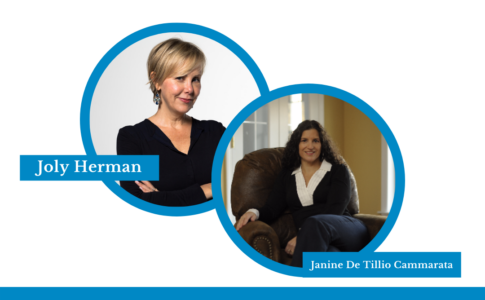Sometimes, the relationship a parent is in becomes unbearable. But what qualifies as abuse? And how do you get your kids out of a dangerous situation?
Today, we are going to talk about getting safe, staying safe, and recovering from an abusive situation with the help of our guest, Christopher Stibbs, Director of Philanthropic Engagement at Newhouse Domestic Violence Shelter in Kansas City, MO. Before he was in this fundraising role, Christopher was an advocate at Newhouse. He answered hotline calls and helped individuals and families out of crisis situations and into a safe place.
In this episode, we discuss…
[2:03] How Christopher started working in a domestic violence shelter
In college, Christopher worked in the center for service learning office helping with volunteer projects. He stumbled across a brochure for Newhouse and checked it out. One of the first things he thought was, what’s domestic violence? It was a very privileged question to ask, as he had not grown up witnessing it. He was looking for a volunteer opportunity at the time, and thought he would give it a try.
Fast forward nine years later, and Newhouse and domestic violence (DV) advocacy would become a huge part of his life. He would go on to do more and more work with domestic violence, as well as to learn that more people in his life had experienced it than he previously realized.
Christopher started as a volunteer at Newhouse and he worked on the hotline through the advocates’ office. It was such a powerful experience. He recalls getting calls where survivors were crying, or apologizing for bothering him. These interactions made him want to do more in the domestic violence realm. Every day was different as an advocate, but the most important thing was ensuring you were there to help people and to be a voice of reason and support. He is very grateful for the time he spent in that office.
[4:35] What it looks like when someone arrives at a domestic violence shelter
Each person gets to the shelter a different way. They work a lot with law enforcement for transportation, and they make sure survivors have safe rides – someone assigned during their time at Newhouse who is a safe person to come pick them up or assist them outside of the shelter. Sometimes a social services agency would bring them, other times people have walked to the shelter.
Some people arrive with nothing but the clothes on their back, so Newhouse provides clothing, personal hygiene products, and food free of charge.
[6:12] How children are cared for at the shelter
Usually around half of the residents are children, and they have worked with newborns through dependents over the age of 18. Of the 88 available beds, they could have 40-45 kids.
When children arrive, sometimes they are rambunctious and running around exploring, and other times they are more tired or unsure. They have been through a lot of trauma as well. They offer a full children’s program, including a therapeutic case manager who works on emotional and social regulation with the child. They also have an onsite director of educational innovation, who builds curriculum for kindergarten through 12th grade. The curriculum brings together therapeutic programs and educational enrichment activities to help reverse the impacts of trauma.
Newhouse also has a full early childhood learning center for children birth to pre-K. They are very passionate about reversing the impacts of trauma for kids, so they can truly break the cycle.
[8:29] A day in the life at a domestic violence shelter
Each day can be different, but in the morning the parents may be going to work if they are working. They also have onsite therapeutic programs for the adult residents, so they could be meeting with a therapist or a case manager who helps them look at budgeting, secure housing, or search for a job. Some of the residents don’t have access to their birth certificate or a social security card, so there are barriers they have to tackle as they move toward life after the shelter. Children might be going to school or participating in the early childhood learning center.
Newhouse also hired onsite legal representation recently, which is powerful. Legal issues can present huge barriers and challenges, as going through the court system can be terrifying. It’s crucial for the families at Newhouse to know they can be safe from their abusers and represented in the way they deserve to be.
[11:22] Recovering from the trauma of abuse
Newhouse has an onsite recovery counselor, who works with anybody who has an identified substance dependency issue. They are very serious about making sure that everybody has the resources they need for healing and recovery, and it’s different for each person. Overall, their goal is to ensure that when they step foot in the shelter it’s a healing place for them to sit down, relax, and breathe. They want to ensure that every aspect of the shelter is a physically and emotionally safe place for the residents to heal. While they realize that they cannot eliminate 100% of the trauma someone has faced, their goal is to reverse the impacts of trauma that feed the cycle of abuse. If they can help people channel their emotions into a positive experience and move forward toward a successful and happy life, that is a success.
[12:51] Moving out of the shelter
There isn’t really a typical stay in the shelter, as each survivor has their own set of barriers that they are facing. One survivor may come in and need two weeks to get on their feet before they develop a plan and have somewhere else to go. Others may need a longer stay in order to work through barriers around looking for a job and finding housing. Maybe they need to go back to school, or maybe they have transportation or childcare barriers. Childcare is a huge issue, because we expect people to get a job but they can’t work without access to childcare and they can’t get access to childcare through the government unless they have a job. That is why they offer the early childhood learning center at Newhouse – to alleviate that barrier both financially and time-wise.
By the time they are ready to leave the shelter, they have had a lot of support and they have worked with a case manager. They help people get into apartments or homes. Two years ago, they received a government grant to help house people for two years. The grant allowed them to provide up to two years of rent and utilities for somebody leaving our program. They work with them to budget in order to ensure they can afford to live in their home when the two years are up, but having that assistance for two years is a huge advantage in building some savings.
Another barrier Newhouse wants to alleviate is generational poverty. Getting out of generational poverty is very tough, and people don’t always understand that. In addition, many people at the shelter have been financially abused or have become anxious around other people or authority figures. Working through that trauma that comes from growing up impoverished is vital to future success.
[15:36] How abusive situations in childhood can impact adult relationships
Statistics show that a child who grows up in an abusive home is three times more likely to be aggressive in a relationship. This is why Newhouse is so committed to reversing the impacts of trauma, because they don’t want the children to go into the world and think that abuse is love.
[16:13] What qualifies as abuse
There are so many different forms of abuse: emotional, psychological, mental, physical, financial, sexual. At the shelter, they welcome anyone who has been in any domestic violence situation. When people think of domestic violence, they often think of physical violence. Christopher shares that people often don’t recognize their own abuse because it wasn’t physical – it was mental or psychological or financial. They think they aren’t in an abusive relationship because their partner hasn’t hit them. Abuse is so much bigger than just physical violence, and Newhouse wants to educate the greater community.
Abuse can entail control, domination, belittling – all the things that can keep someone within a power dynamic that isn’t an equal dynamic. Someone may feel trapped and unable to get out of a situation with another person. Emotional or other non-physical abuse can devolve into physical abuse over time, as well. By the time it gets to that point, someone may have been psychologically abused for years and feeling so isolated that they don’t know where to turn or don’t feel they have anything to contribute to the world.
One of the questions frequently asked about domestic violence survivors is why they didn’t just leave. Christopher says, “Try to put it in the perspective of somebody who has married the love of their life. This individual did not start out abusive. He or she started out, let’s say, very kind and funny and friendly and warm, and you fall in love. And little things start to happen time by time, until it grows and it escalates.”
A survivor once told Christopher, “I don’t want my marriage to end. I just want the abuse to stop.” If you haven’t experienced it, it’s so hard to fathom what it is like for a survivor. You can’t always just walk out the door. There are so many reasons why someone doesn’t leave, and Christopher urges us to dismantle this judgmental thought process.
[19:35] Everyone is worthy of help
At the shelter, they house men, women, and children. They really pride themselves on being the first shelter to house individuals who identified as transgender in the early 2000s as well as the first shelter in their metro area to house men. They have had men come in with their children, and they have helped men to get custody of their children. They are very firm on wanting to help all individuals in their community, regardless of sexual orientation, gender, religion, ethnicity, or socioeconomic status. Domestic violence doesn’t discriminate, and they are here to help everyone.
[20:32] Statistics on relational violence
Statistics suggest that around 25% of divorces happen because of domestic abuse. The old “rule of thumb” was that 1 in 4 women and 1 in 7 men will experience some form of domestic violence, but Christopher shares that newer research shows it is 1 in 3 women and 1 in 4 men. He thinks it may be that more than 25% of divorces are related to domestic violence, but people may not recognize that or be willing to admit it.
In the Kansas City metro area alone, they could fill Kauffman Stadium 11 times without repeating anyone with the amount of people who have experienced or will experience domestic violence. For those of you who are unfamiliar with the stadium, the Kansas City Royals play there and it seats around 40,000 people.
If even a half percent of those people needed shelter tonight, that is about 2000 beds. They have less than 350 beds at domestic violence shelters in the Kansas City metro area and Newhouse has 88 of them.
[22:46] Helping our kids to avoid abusive relationships
Christopher suggests having conversations with our children about what healthy and unhealthy relationships look like. It’s important to discuss the signs of teen dating violence or abuse. Do they talk down to you? Are they always trying to control what you are doing? Do they always need to know where you’re at? Do they have points where they get really angry with you, but then it goes into a honeymoon phase before turning bad again?
Teen dating violence is a whole other can of worms that we are trying to tackle as a society, especially with social media and the ability to know where people are and what they are doing 24/7. Social media is also a platform that can provide opportunities for abusers to air dirty laundry and make threats.
It is also important to recognize that abusers can be very charming when other people are around, and vicious when nobody is looking. If we don’t understand that, people can feel discredited because they don’t think others will believe them when they share their stories of abuse.
[26:46] Domestic violence and the legal system
It’s really hard when a legal situation becomes a he said, she said scenario because the judge can only go off the evidence. Sometimes, there is no evidence. The police can come out, but if someone doesn’t press charges because they’re afraid or they don’t know what will happen, it can come back to bite them. If you don’t press charges, the legal system can interpret that as a lack of abuse.
There are so many layers, and so much work that still has to be done in the judicial system to empower survivors. Christopher says that less than 3% of people make up an abusive situation in court. That means that 97% of people are telling the truth. It can really rear its head as a custody issue. If a survivor tries to get an order of protection for them and their child against the abuser, it will get put to family court because they think that the survivor is using abuse as an excuse or a ploy to get full custody of the child. Survivors face many different barriers in the legal system as it currently stands.
[28:21] The cycle of abuse
The odds are that somebody will return to their abuser 7-8 times before they either leave for good or the abuser kills them. This is an unimaginable statistic, and it’s so hard to get a grasp on. An abused person is already vulnerable, and it feels good to be comforted after someone has hurt them. They will go back into a honeymoon phase, but then the abuse may get worse every time. It’s all part of the cycle Newhouse wants to break for survivors of domestic violence.
[29:56] Support for children who have experienced abuse
Newhouse really prioritizes resources for children. They don’t want children to grow up thinking abuse is normal or that it is the way to show love. Abusers will often tell children they do it because they love them. This thought process is where Newhouse wants to intervene, because they want to make sure children have models of healthy relationships.
Once someone is out of the shelter and in a safe place, they want to make sure those families can access ongoing therapy. They have a full outreach program, and people can come back to the shelter for therapy or to use the early childhood learning center. They want their families to have everything they need to be successful.
[32:08] A success story
Christopher shares a success story about a woman who had been through a pretty horrific, abusive marriage and had the courage to leave and find shelter and safety. She was in Newhouse’s program for over a year, and she came into the advocates’ office to tell them that she would be sharing her story at an event. She read her speech to Christopher, and it was amazing. In the last couple years, she got married to a good man and she has been successful since leaving Newhouse. It gives Christopher such a warm feeling to see her posts and see how happy she is and how well she is doing. They want everybody who comes through their doors to be able to move on and be successful, happy, and healthy.
[35:12] Christopher’s book project
They are in the early stages of working on a book of handwritten letters from domestic violence survivors. These letters would be written to somebody who may be in an abusive relationships or to someone who is just leaving. They want each page to have a different handwritten letter on stationary, so someone can gain hope and encouragement from other survivors and realize they are not alone.
If you are interested in participating in this project, you can connect with Christopher through https://newhousekc.org .
Families who need to heal can find help in their communities. The more you know about issues like domestic violence, the better prepared you will be to teach your children about staying safe.
Connect with Christopher:
https://www.linkedin.com/in/christopherstibbs/
Resources:






